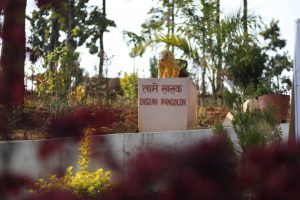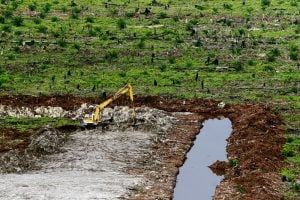Sveinung Rotevatn, the Norwegian Minister of Climate and Environment, was on a week long visit to India, his first to the country. At an evening meeting on 18 February 2020 at the Norwegian Embassy, he spoke of the success of the visit, of learning about mangroves and the cleaning up of Versova Beach by Afroz Shah, of win-win solutions in Gujarat for heating and cooking without use of hydrofluorocarbons (HFCs), and the release of a joint statement on the sustainable use of the oceans with the Indian Environment Minister, Prakash Javadekar.
Born in May 1987, Rotevatn is the face of the Liberal Party in Norway, the junior partner in the governing coalition. The Liberal Party is known for its environmental stance, and Rotevatn has also served as the state secretary in the same ministry. In a freewheeling interview, he spoke to thethirdpole.net on his experience and expectations from the India visit, the challenges of climate diplomacy, the importance of indigenous peoples’ rights, and the rise of difficult regimes.
Excerpts:
What are your key takeaways from your India visit? What you would describe as successes?
I had excellent meetings with the Ministers of the Environment and the Minister of Health [who is also the Minister of Earth Sciences]. The joint statement [released by the Indian environment minister and myself] was very good, and a move ahead. It emphasised our common commitment to move towards an international agreement on marine littering, which is very important to us.
A lot of the India-Norway cooperation is through the Ministry of Earth Sciences (MoES).
Yes, and we were happy that they were interested in sharing experiences. Norway has an integrated ocean management plan, and they were interested in seeing how India could make it work.
What is an integrated ocean management plan?
This is like a master plan for the ocean, through which one can balance the needs of the environment, conflict between resources, the petroleum industry and the fisheries. The ocean is often seen as vast, but there is the scope of real conflicts in areas.
But how can the same plan work when the size, income per capita, and population of India is not really comparable to that of Norway?
The ocean territory is quite comparable. We have a huge coastline and have had quite a few conflicts with countries like the UK and Iceland [over its management]. We have had fish stocks fished into unsustainability. While the poverty challenges in India are large, it is not as if our fishing communities started out rich. We need to be able to offer options, and distribute resources fairly.
One of those issues is the conflict between the large fishing industry and local fishermen.
How does Norway manage that?
We distribute quotas for every fish species, as well as cap the amount that small fishermen can catch on their own, and that large fishing companies can. This requires deep scientific knowledge [something that the MoES was interested in] of how much fish are there, which species, how the fish stock moves. It requires more research. We also take the recommendations from our environmental agencies very seriously.
Do indigenous communities have any input into this?
Norway has historically had pretty high levels of conflict between the indigenous community and the government, and there have been serious transgressions by the central government in the past, like suppressing indigenous culture, and not teaching them their own language. Now we recognise that the Kingdom of Norway is a land of two peoples, the Norwegians and the Sami – our main indigenous community – and have created ways for them to manage land and fishing rights, as well as the management of reindeer husbandry, a traditional source of livelihood.
Does this play out in international diplomacy?
Indigenous people are key to sustainably managing forests. We have brought this into our climate negotiations and plans. Norway is the biggest supporter of tropical rainforest preservation, and in our partnerships with Brazil and Indonesia the role of indigenous people as the custodians of forests has been emphasised.
Is this still possible with the new government in Brazil?
It is quite difficult. We have tried to work with the new regime, but have encountered problems. The new Brazilian government [under Jair Bolsonaro] wanted to change the set up of how the fund is run, giving the central government more power versus civil society actors and indigenous communities. New funding for the Amazon Fund has now been frozen, although funding for work already done by the Brazilian government is continuing.
We have had a pushback from a number of new regimes, does this mean there is backsliding on climate change diplomacy?
Our cooperation in other places such as Indonesia, Colombia, Gabon and Guyana is still going well, and we hope we can work out a new way to deal with Brazil. But there is some progress. The last Climate COP was not a major breaking point [although it was disappointing]. We thought it was heading towards disaster. The next COP, in Glasgow this fall, will be the proof of the pudding.
The problem is that we are heading towards 3 degrees Centigrade of warming [over pre-Industrial Age] which will be disastrous. Not only are countries not doing enough, they are not promising enough. Two weeks ago Norway enhanced its Nationally Determined Contribution (NDC) goals under the Paris Agreement, committing to reducing its emissions by 50% by 2030, becoming the first industrialised country, and only the third country overall to go for enhanced commitments.
But we need everyone. Nobody is big enough to do this on its own, not even China is big enough. And while the withdrawing of the US from the Paris Agreement is a problem, no other country has done so. Brazil spoke about it, but has not done so, and the Russian Federation has ratified the Agreement.
How do industrialised nations and developing countries cooperate towards this goal? Developing countries, with low per capita GDP, cannot abandon their drive to prosperity.
We want Norway to cooperate with others to phase out coal. There is no trouble investing in renewables, but that does not help if you do not phase out coal. That is very difficult to do. For example we are working with Vietnam to subsidise renewables, but they are also building coal-based power plants. That just means you have renewables and coal. [That does not cut emissions]. These efforts must be tied to NDCs.
Is that not easy to say for Norway, which produces so much gas and oil?
We are kind of a paradox. Our domestic economy is phasing out fossil fuels, but we are still exporting fossil fuels. There are strong and different views on this. My party is on the environmental side, and have argued for more restrictions. Norway has committed to not opening up new and vulnerable areas for oil exploration such as the Lofoten archipelago. We have raised taxes, but not even those on the environmental side have said we must stop altogether.
Errata: In the first version of this article “Ireland” was mentioned instead of “Iceland”. The mistake is regretted.
![<p>Sveinung Rotevatn, Norway’s Minister for Climate and the Environment [image courtesy: Norwegian Ministry of Climate and Environment]</p>](https://dialogue.earth/content/uploads/2020/02/Sveinung-Rotevatn.jpg)


![Snow and rain in April 2016 was disastrous for Gilgit-Baltistan [image courtesy Pamir Times]](https://dialogue.earth/content/uploads/2016/04/snow-picture-Credit-to-PAMIR-Times-300x169.jpg)




